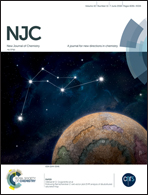Electrochemical performance enhancement of graphite negative electrode by nano-metallic-oxides
Abstract
Severe mechanical strain and rapid capacity decay during Li+ insertion/extraction processes restrict the potential applications of copper oxides as lithium-ion battery anode materials and modified electrode materials. Herein, a new method for obtaining nano-copper-oxides by decomposing Cu(CH3COO)2·H2O at high temperatures was put forward to improve the electrochemical properties of graphite. Moreover, the positive effects of LiAlO2 and Al2O3 on the electrochemical properties of natural graphite have been proved by our laboratory. Then, the modified graphite containing these nano-metallic-oxides was fabricated by solution mixing and high-temperature sintering. The discharge capacity was 493.3 mA h g−1 at 0.5C after 120 cycles, which significantly increased from 522.8 to 675.9 mA h g−1 after 155 cycles at 0.1C. Microstructural analysis showed that the thickness of the graphite layers and the degree of disorder were caused by the chemical reactions. First-principles calculations were performed to investigate the structure, conductivity and lithium storage properties of the graphite that was intercalated by different metal ions. The results prove that metal insertion can efficiently improve the performance of the material.



 Please wait while we load your content...
Please wait while we load your content...